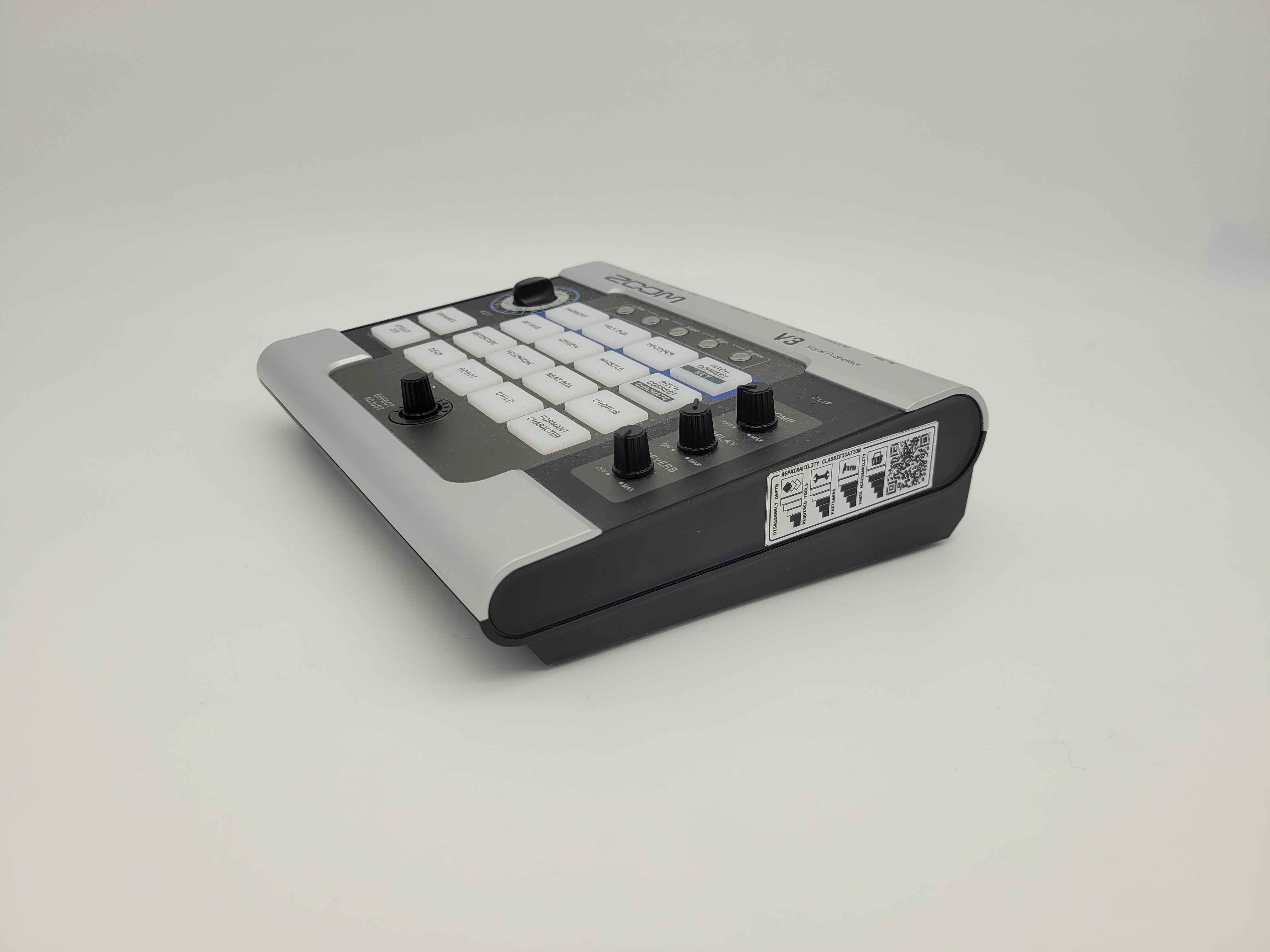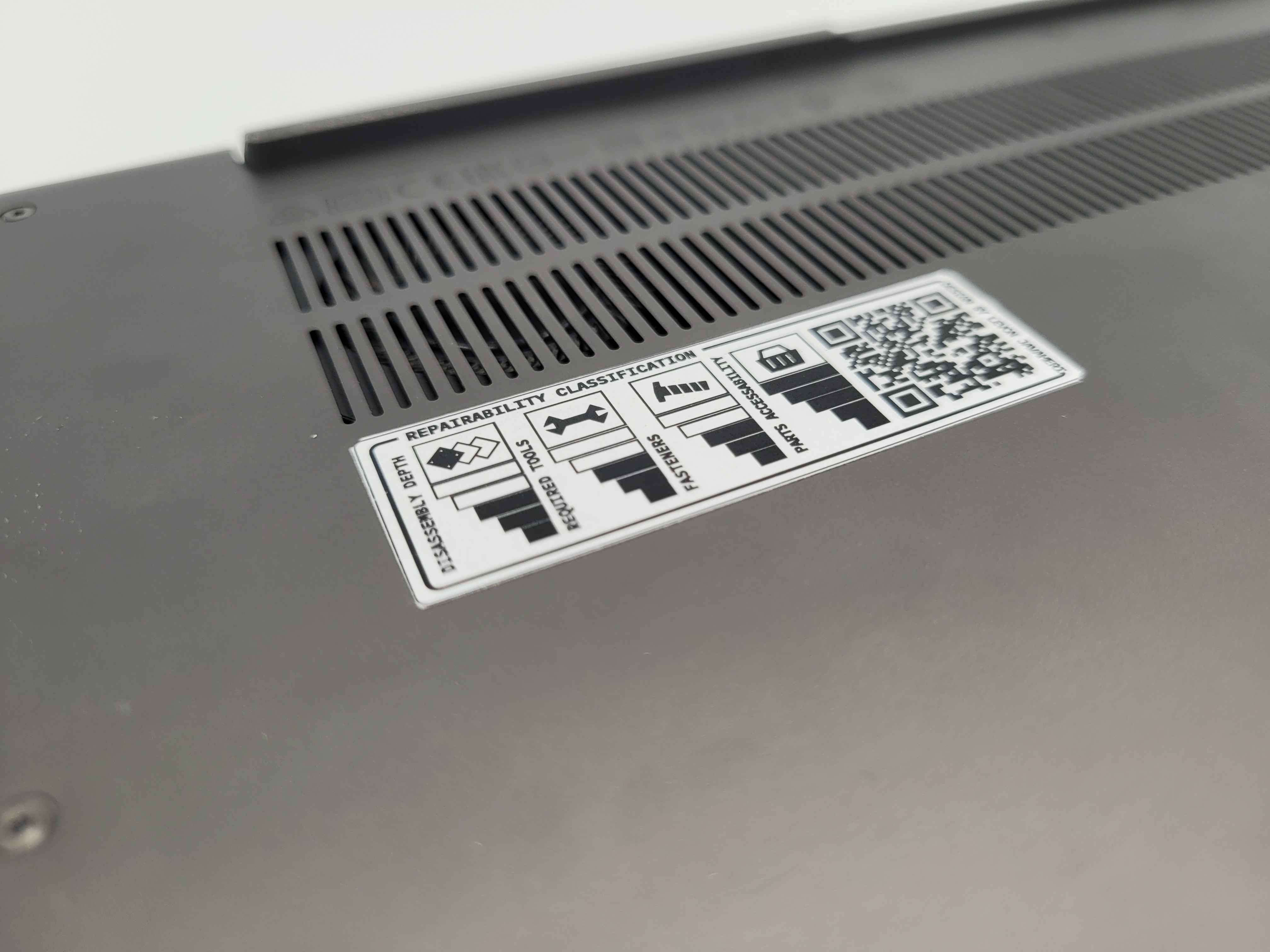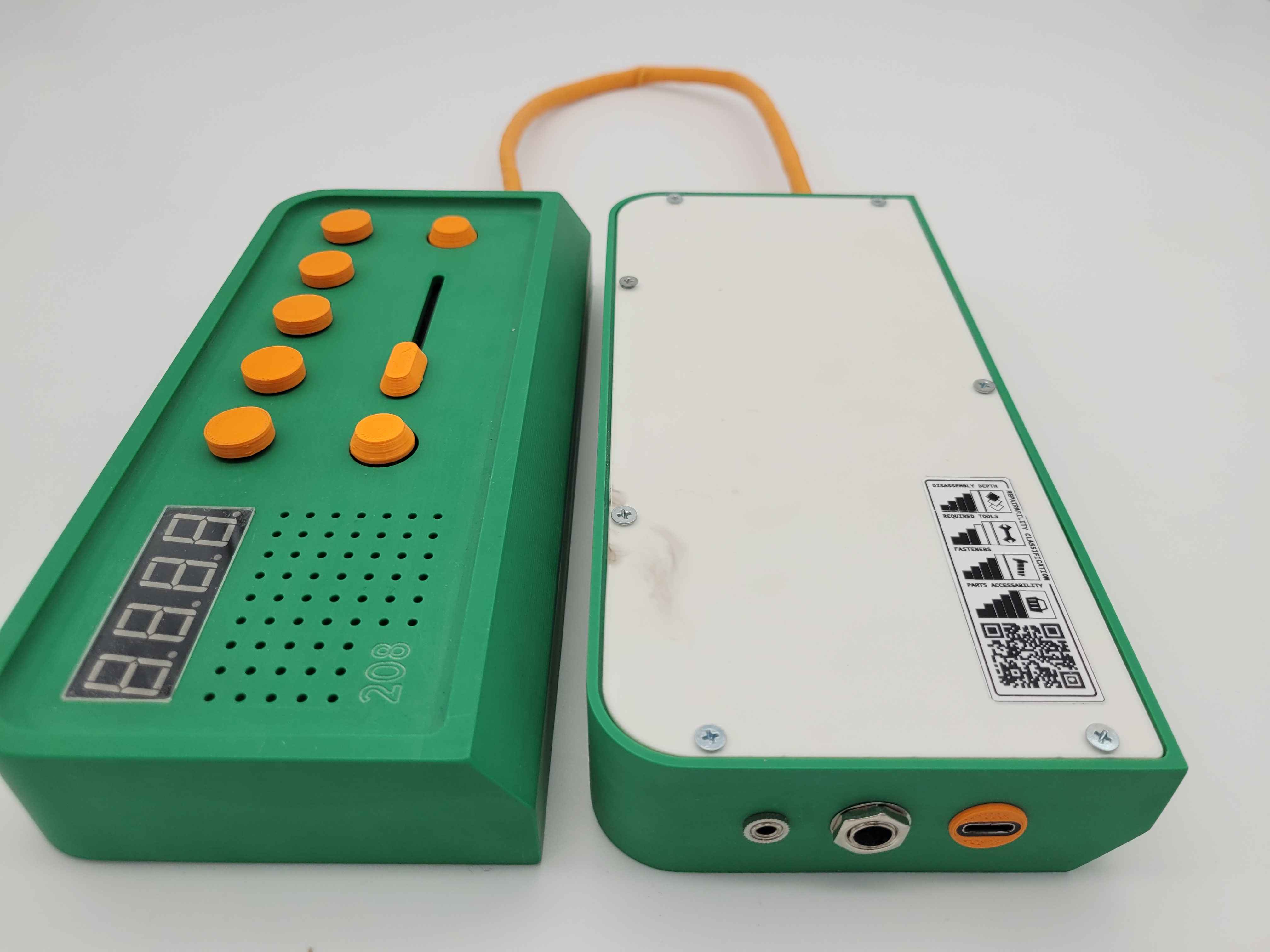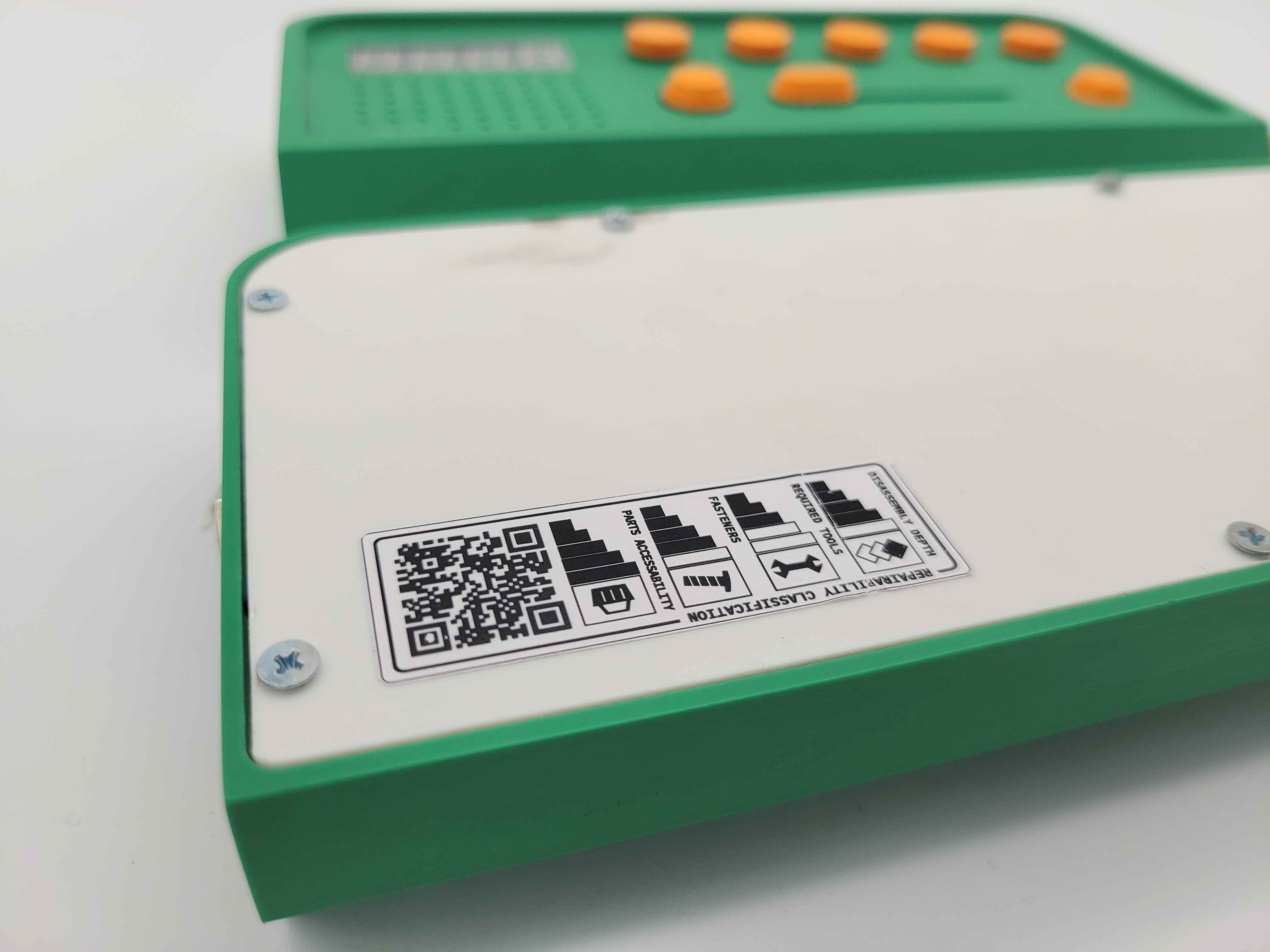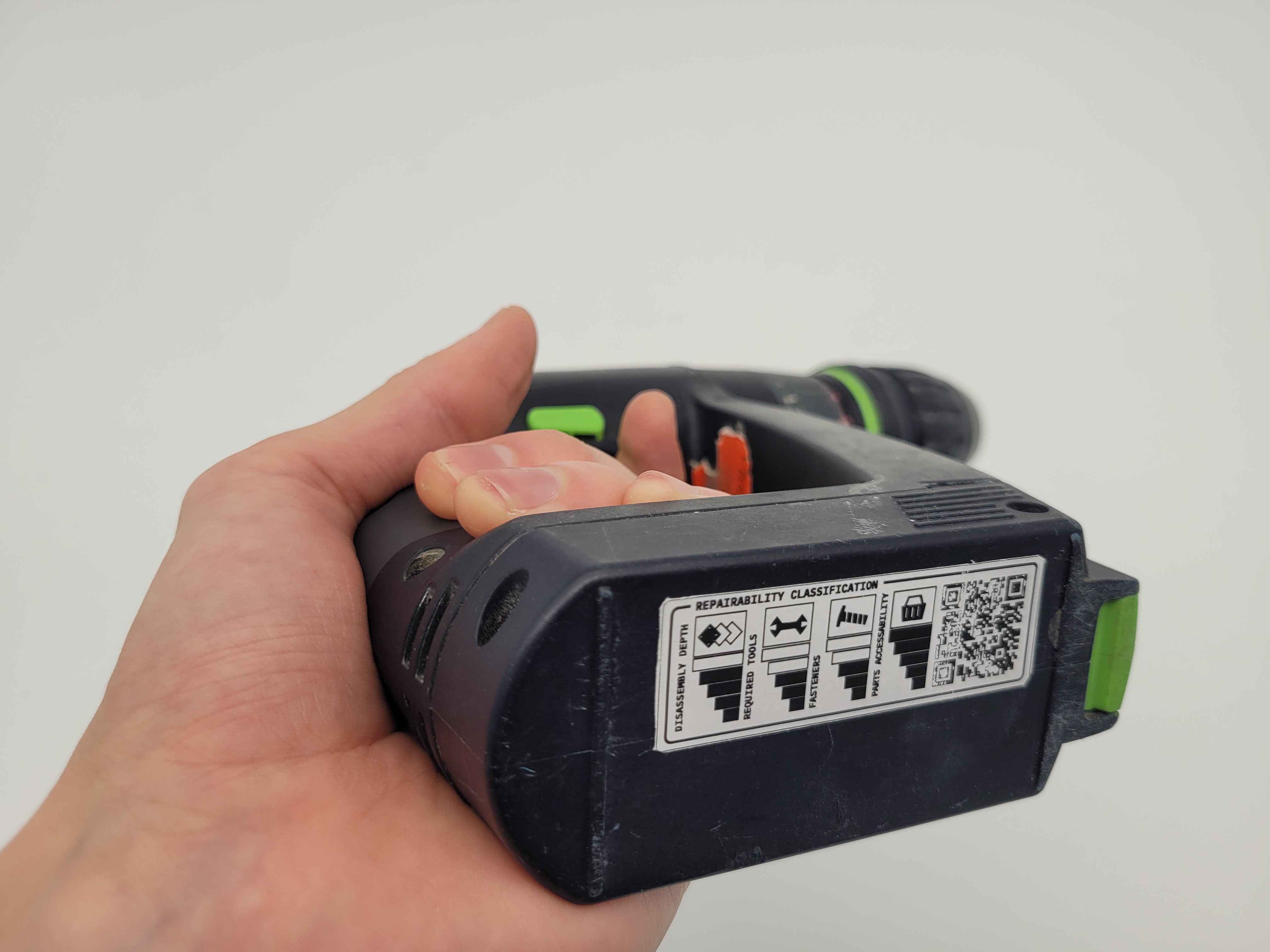Shaping a circular industrial ecosystem and supporting life-cycle thinking
Repairability classification system
Repairability classification system (RCS)
The Repairability Classification System (RCS) is an accessible, consumer-friendly labeling system that rates products based on their ease of repair - evaluating disassembly, required tools, fasteners, and spare part availability. Each label includes a QR code linking to repair guides, local services, and a community-driven platform. By increasing transparency, RCS promotes sustainable consumption, extends product lifespans, and encourages more repairable design practices.
Germany
National
Mainly urban
It refers to other types of transformations (soft investment)
Prototype level
No
No
As an individual
The Repairability Classification System (RCS) is a standardized labeling system designed to make repairability transparent and accessible while challenging unsustainable design practices that hinder repairs and instead encourages repair as a viable option for users while incentivizing manufacturers to create more repairable products. By providing clear repairability ratings, the system empowers consumers, supports repair professionals, and encourages manufacturers to design products with longevity in mind.
RCS serves multiple stakeholders, including consumers seeking repair-friendly products, manufacturers looking to improve sustainability practices, repair professionals benefiting from increased accessibility, and policymakers advocating for a circular economy. By bridging these groups, RCS fosters a shift towards a more repairable and sustainable future.
The labeling system evaluates products based on four key criteria: depth of disassembly, required tools, fasteners, and spare part availability. Each category is rated from 1 to 5, with higher scores indicating a more repair-friendly design. A QR code on each label links to a community-driven repair platform that provides product-specific repair guides, a map of local repair shops, and a space for users to share repair experiences.
By making repairability information visible and accessible, RCS facilitates informed purchasing decisions, extends product lifespans, and highlights the need for improved design practices. Rooted in existing EU research and repairability metrics, the system is designed to evolve through continuous testing and engagement with the repair community.
RCS serves multiple stakeholders, including consumers seeking repair-friendly products, manufacturers looking to improve sustainability practices, repair professionals benefiting from increased accessibility, and policymakers advocating for a circular economy. By bridging these groups, RCS fosters a shift towards a more repairable and sustainable future.
The labeling system evaluates products based on four key criteria: depth of disassembly, required tools, fasteners, and spare part availability. Each category is rated from 1 to 5, with higher scores indicating a more repair-friendly design. A QR code on each label links to a community-driven repair platform that provides product-specific repair guides, a map of local repair shops, and a space for users to share repair experiences.
By making repairability information visible and accessible, RCS facilitates informed purchasing decisions, extends product lifespans, and highlights the need for improved design practices. Rooted in existing EU research and repairability metrics, the system is designed to evolve through continuous testing and engagement with the repair community.
Repairability
Cycle-Economy
User-Touchpoint
Transparency
Sustainable devellopment
The Repairability Classification System (RCS) promotes sustainability by prioritizing the extension of product lifespans, minimizing waste, and fostering responsible production practices. By enhancing the transparency and accessibility of repair information, RCS encourages consumers to choose repair over disposal, thereby conserving resources, reducing the demand for new products, and mitigating environmental impact.
Aligned with the principles of a circular economy, RCS supports the design of products intended for repair and reuse, rather than for premature obsolescence. The system provides consumers with clear, actionable repairability ratings, enabling them to make informed purchasing decisions that emphasize durability and long-term usability.
Furthermore, RCS incentivizes manufacturers to incorporate repairability into product design, thereby challenging unsustainable practices that contribute to planned obsolescence. Products designed with repairability in mind help reduce e-waste, conserve valuable materials, and promote more sustainable manufacturing practices.
Summarizing the above, the RCS is an effective tool for advancing sustainability by simplifying the repair process, reducing waste, and encouraging both consumers and manufacturers to adopt more durable, eco-conscious design practices.
Aligned with the principles of a circular economy, RCS supports the design of products intended for repair and reuse, rather than for premature obsolescence. The system provides consumers with clear, actionable repairability ratings, enabling them to make informed purchasing decisions that emphasize durability and long-term usability.
Furthermore, RCS incentivizes manufacturers to incorporate repairability into product design, thereby challenging unsustainable practices that contribute to planned obsolescence. Products designed with repairability in mind help reduce e-waste, conserve valuable materials, and promote more sustainable manufacturing practices.
Summarizing the above, the RCS is an effective tool for advancing sustainability by simplifying the repair process, reducing waste, and encouraging both consumers and manufacturers to adopt more durable, eco-conscious design practices.
The key objectives of the Repairability Classification System in terms of aesthetics and quality of experience focus on providing a seamless, user-friendly interaction with products while emphasizing the cultural benefits of repairability and sustainability. The design of the RCS label is intentionally simple, unobtrusive, and adaptable to various product styles, ensuring that it aligns aesthetically with the product while clearly communicating its repairability features. This thoughtful design ensures that the label enhances the consumer experience without detracting from the product's visual appeal. High contrasts also ensure inclusive visual communication but the design still has to advanced, and tested with different user groups.
Culturally, the RCS promotes the values of sustainability and repair, encouraging a shift in how society views product longevity and waste. By making repairability visible and easily accessible, it fosters a sense of ownership and responsibility among consumers, contributing to a more sustainable, circular mindset. The project also facilitates a deeper connection between consumers and the objects they use, emphasizing the value of maintaining and extending the life of products.
In this context, the project is exemplary because it not only meets the functional needs of repairability but also integrates these principles into the aesthetic and cultural fabric of everyday consumer goods. It exemplifies how sustainable practices can be seamlessly woven into product design, offering both a practical solution and a cultural shift towards responsible consumption.
Culturally, the RCS promotes the values of sustainability and repair, encouraging a shift in how society views product longevity and waste. By making repairability visible and easily accessible, it fosters a sense of ownership and responsibility among consumers, contributing to a more sustainable, circular mindset. The project also facilitates a deeper connection between consumers and the objects they use, emphasizing the value of maintaining and extending the life of products.
In this context, the project is exemplary because it not only meets the functional needs of repairability but also integrates these principles into the aesthetic and cultural fabric of everyday consumer goods. It exemplifies how sustainable practices can be seamlessly woven into product design, offering both a practical solution and a cultural shift towards responsible consumption.
RCS is designed with inclusion as a central objective, ensuring accessibility, affordability, and broad societal benefits. By providing a clear and standardized labeling system, RCS makes repairability information easily accessible to all consumers, regardless of technical expertise. The system promotes affordability by encouraging repairs over replacements, pushing producers to make spare parts and local services more accessible and cost-effective. It also fosters inclusive design principles by encouraging manufacturers to create products that are easy to repair, with user-friendly features such as modular components and standard fasteners. Additionally, RCS supports new societal models by shifting focus from short-term consumption to long-term product use and sustainability. The community-driven repair platform further enhances inclusivity by allowing users of varying backgrounds to share knowledge and experiences, creating a participatory ecosystem. In this way, RCS contributes to a more inclusive, equitable, and sustainable approach to product consumption and repair.
Interviews have been done with individuals which repair objects regulary and with an expert in repair services, who had his own repair-shop. Additionally, the understandability of the designed labels has been tested on several students at KISD university in cologne.
There have also been Interviews with designers which could try the labeling system on their own objects as "manufacturers" to understand the possible needs from the production side.
As this project is still in it's early phases, the prototypes now have to be tested with various stakeholders and develloped including the knowledge of repair-professionals from different fields. This will be further described in the Project-Outline.
There have also been Interviews with designers which could try the labeling system on their own objects as "manufacturers" to understand the possible needs from the production side.
As this project is still in it's early phases, the prototypes now have to be tested with various stakeholders and develloped including the knowledge of repair-professionals from different fields. This will be further described in the Project-Outline.
At this stage, the engaged stakeholders were mainly the KISD university in cologne, where the project was presented. Besides this, the EU research on the topic was passively involved through their papers and a collaboration with the authors of "Analysis and development of a scoring system for repair and upgrade of products" aswell as "Repair Score Study:
Product specific application to Smartphones and Tablets" would be very benefitial for the success of this innitiative.
Further stakeholders would be local governments and policy makers which could support to spread the innitiative. This kind of Project is not able to be realized without the support of governal structures like the EU and so their involvement is crucial for further steps.
Product specific application to Smartphones and Tablets" would be very benefitial for the success of this innitiative.
Further stakeholders would be local governments and policy makers which could support to spread the innitiative. This kind of Project is not able to be realized without the support of governal structures like the EU and so their involvement is crucial for further steps.
The design and implementation of the Repairability Classification System involved expertise from the fields of industrial design, engineering, graphic and user experience (UX) design, and community-driven platforms. The industrial design was focused on creating a simple, adaptable label that could be applied to various products, while repair experts and scientific resources defined the technical criteria for evaluating repairability, such as disassembly ease and fasteners. Creating simple graphics and utilizing rules from UX design, ensured the label and linked platform were user-friendly, making repair information accessible to all. The development of a community-driven platform encourages collaboration and knowledge sharing among users. The interaction between these fields ensures the RCS will be both technically effective and socially engaging, offering a comprehensive solution to promoting repairability.
The RCS innitiative stands out as an innovative approach especially in the field of product sustainability and repairability by focusing on consumer empowerment and accessibility. Unlike mainy other initiatives that primarily target manufacturers through regulations or general repairability scores, RCS introduces a transparent, user-friendly labeling system that directly engages consumers. The system not only evaluates repairability across specific, actionable criteria but also connects users to a community-driven platform with repair guides, local resources, and shared experiences. This holistic approach, combining product design, consumer education, and community collaboration, makes RCS unique, driving a shift from passive consumerism to active participation in extending product lifespans. By providing clear, practical information and fostering a repair culture, RCS offers a inclusive, accessible, and sustainable solution.
The project was based on research which is still ongoing and has to be expanded to guarantee the necessary scientific background a project with a scope this big needs. Besides general repairability field research on repairing household objects like toasters, sewing-machines, microwaves etc. , the insights of "repair-experts" and users was very valuable in devellopment and should also remain as supporting structure for all upcomming steps. The graphics and layouts were designed digitally, keeping in mind the inclusivity norms and necessary aspects to allow all users to read the labels.
This approach guarantees that the system is both accessible and practical for a diverse range of users, from novice to experienced repairers.
The project follows an iterative approach, where ongoing feedback from users and repair professionals informs continuous improvements. This ensures that the RCS remains relevant, user-friendly, and based on up-to-date insights from the repair community, driving sustainability through accessible, long-lasting product repair solutions.
This approach guarantees that the system is both accessible and practical for a diverse range of users, from novice to experienced repairers.
The project follows an iterative approach, where ongoing feedback from users and repair professionals informs continuous improvements. This ensures that the RCS remains relevant, user-friendly, and based on up-to-date insights from the repair community, driving sustainability through accessible, long-lasting product repair solutions.
The RCS was generally designed to be replicated or transferred to a wider scope, like the whole EU contect. The methodology of evaluating repairability through clear, standardized criteria can be adapted to a wide range of products, including electronics, furniture, or even automotive parts. This flexibility allows other industries to assess and improve product designs based on ease of repair, making the approach universally applicable.
The technology behind the system, particularly the use of QR codes linking to a community-driven repair platform, can be expanded to various product categories and geographical regions. This technology allows consumers to easily access repair guides, locate local repair shops, and share knowledge. The platform itself can be adapted to serve different languages, cultures, and needs, creating a international network of resources that benefits consumers worldwide.
The processes used in the RCS, including the collaborative, user-driven platform where individuals contribute repair experiences and tips, can and should be replicated in diverse cultural and social contexts. This model fosters a sense of shared responsibility for sustainability and empowers communities to engage in repairs, reducing dependency on disposable products.
Finally, the learnings gained from feedback provided by users and repair experts are valuable for future iterations of the RCS, allowing the system to continuously evolve based on real-world experiences. These insights can be applied to similar projects in different regions or industries, improving the design, usability, and impact of the system.
Together, these elements create a scalable and adaptable framework that can promote repairability, sustainability, and responsible consumption on an international scale, benefiting a wide range of consumers, manufacturers, and local communities aswell as the European Union as a resource for further projects.
The technology behind the system, particularly the use of QR codes linking to a community-driven repair platform, can be expanded to various product categories and geographical regions. This technology allows consumers to easily access repair guides, locate local repair shops, and share knowledge. The platform itself can be adapted to serve different languages, cultures, and needs, creating a international network of resources that benefits consumers worldwide.
The processes used in the RCS, including the collaborative, user-driven platform where individuals contribute repair experiences and tips, can and should be replicated in diverse cultural and social contexts. This model fosters a sense of shared responsibility for sustainability and empowers communities to engage in repairs, reducing dependency on disposable products.
Finally, the learnings gained from feedback provided by users and repair experts are valuable for future iterations of the RCS, allowing the system to continuously evolve based on real-world experiences. These insights can be applied to similar projects in different regions or industries, improving the design, usability, and impact of the system.
Together, these elements create a scalable and adaptable framework that can promote repairability, sustainability, and responsible consumption on an international scale, benefiting a wide range of consumers, manufacturers, and local communities aswell as the European Union as a resource for further projects.
The Repairability Classification System addresses several global challenges by providing local solutions that promote sustainability, reduce waste, and empower consumers. One of the primary challenges is the growing issue of electronic waste, which has reached alarming levels worldwide. By encouraging repair over replacement, RCS helps to reduce unnecessary demand for new products, extending the lifespan of existing goods and curbing the accumulation of e-waste.
The project also tackles the global problem of planned obsolescence, where products are designed to have a limited lifespan, making repair difficult or impossible. By providing clear repairability information, RCS incentivizes manufacturers to design products that are more durable, modular, and easier to repair, contributing to more sustainable production practices.
On a broader scale, RCS promotes the principles of the circular economy by encouraging the repair and reuse of products rather than their disposal. This approach reduces resource consumption, lowers environmental impact, and helps preserve valuable materials. By focusing on local solutions, such as connecting users to nearby repair shops and resources through a community-driven platform, RCS fosters local economies and strengthens repair ecosystems and sustainable devellopments on global scales.
The project also tackles the global problem of planned obsolescence, where products are designed to have a limited lifespan, making repair difficult or impossible. By providing clear repairability information, RCS incentivizes manufacturers to design products that are more durable, modular, and easier to repair, contributing to more sustainable production practices.
On a broader scale, RCS promotes the principles of the circular economy by encouraging the repair and reuse of products rather than their disposal. This approach reduces resource consumption, lowers environmental impact, and helps preserve valuable materials. By focusing on local solutions, such as connecting users to nearby repair shops and resources through a community-driven platform, RCS fosters local economies and strengthens repair ecosystems and sustainable devellopments on global scales.
In the year following the application, the Repairability Classification System has to be refined with the help of EU-Researchers and a wider scope of expertise has to be gathered aswell as usability testing and conversations with producers. Also the RCS should be expanded in its product range, focusing on categories like electronics and appliances. It will enhance the repair platform with more guides and resources while fostering stronger connections between users and manufacturers, encouraging the adoption of repairable designs. The digital platform has to be set up and will be improved with multilingual support and new features. Collaboration with policymakers and partnerships with sustainability-focused organizations will further promote the system, ensuring continuous refinement through feedback, ultimately driving a shift towards a more sustainable, repairable future.
Most importantly, after the refinement phase, the RCS has to be tested on a product range and these pilot implementations have to be observed and used to increase the feasibility of the whole initiative. Also additional educational media has to be generated to get the users to participate and take part in the repairability transformation.
Most importantly, after the refinement phase, the RCS has to be tested on a product range and these pilot implementations have to be observed and used to increase the feasibility of the whole initiative. Also additional educational media has to be generated to get the users to participate and take part in the repairability transformation.

